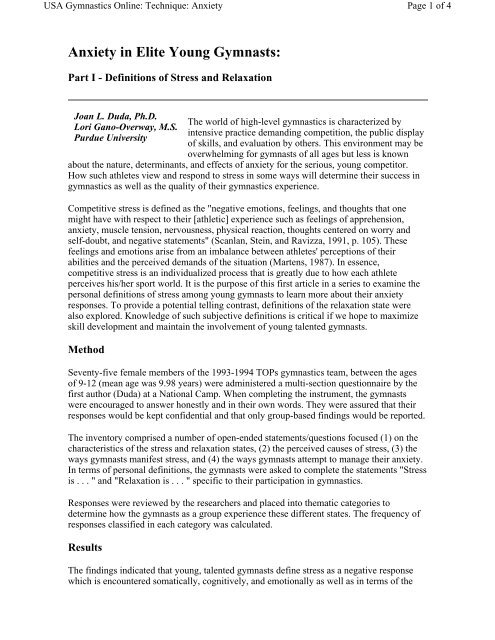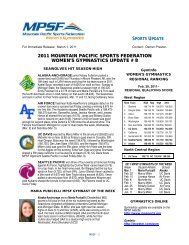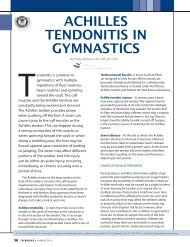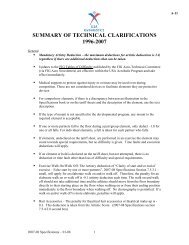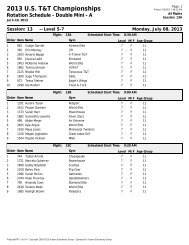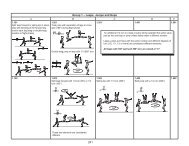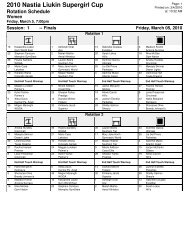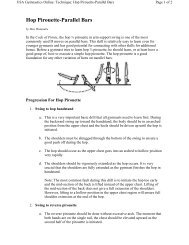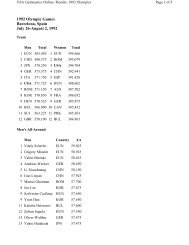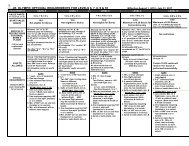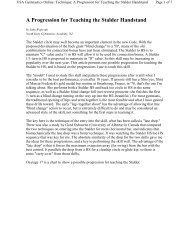Anxiety in Elite Young Gymnasts: Part 1 - USA Gymnastics
Anxiety in Elite Young Gymnasts: Part 1 - USA Gymnastics
Anxiety in Elite Young Gymnasts: Part 1 - USA Gymnastics
You also want an ePaper? Increase the reach of your titles
YUMPU automatically turns print PDFs into web optimized ePapers that Google loves.
<strong>USA</strong> <strong>Gymnastics</strong> Onl<strong>in</strong>e: Technique: <strong>Anxiety</strong><br />
Page 1 of 4<br />
<strong>Anxiety</strong> <strong>in</strong> <strong>Elite</strong> <strong>Young</strong> <strong>Gymnasts</strong>:<br />
<strong>Part</strong> I - Def<strong>in</strong>itions of Stress and Relaxation<br />
Joan L. Duda, Ph.D.<br />
Lori Gano-Overway, M.S.<br />
Purdue University<br />
The world of high-level gymnastics is characterized by<br />
<strong>in</strong>tensive practice demand<strong>in</strong>g competition, the public display<br />
of skills, and evaluation by others. This environment may be<br />
overwhelm<strong>in</strong>g for gymnasts of all ages but less is known<br />
about the nature, determ<strong>in</strong>ants, and effects of anxiety for the serious, young competitor.<br />
How such athletes view and respond to stress <strong>in</strong> some ways will determ<strong>in</strong>e their success <strong>in</strong><br />
gymnastics as well as the quality of their gymnastics experience.<br />
Competitive stress is def<strong>in</strong>ed as the "negative emotions, feel<strong>in</strong>gs, and thoughts that one<br />
might have with respect to their [athletic] experience such as feel<strong>in</strong>gs of apprehension,<br />
anxiety, muscle tension, nervousness, physical reaction, thoughts centered on worry and<br />
self-doubt, and negative statements" (Scanlan, Ste<strong>in</strong>, and Ravizza, 1991, p. 105). These<br />
feel<strong>in</strong>gs and emotions arise from an imbalance between athletes' perceptions of their<br />
abilities and the perceived demands of the situation (Martens, 1987). In essence,<br />
competitive stress is an <strong>in</strong>dividualized process that is greatly due to how each athlete<br />
perceives his/her sport world. It is the purpose of this first article <strong>in</strong> a series to exam<strong>in</strong>e the<br />
personal def<strong>in</strong>itions of stress among young gymnasts to learn more about their anxiety<br />
responses. To provide a potential tell<strong>in</strong>g contrast, def<strong>in</strong>itions of the relaxation state were<br />
also explored. Knowledge of such subjective def<strong>in</strong>itions is critical if we hope to maximize<br />
skill development and ma<strong>in</strong>ta<strong>in</strong> the <strong>in</strong>volvement of young talented gymnasts.<br />
Method<br />
Seventy-five female members of the 1993-1994 TOPs gymnastics team, between the ages<br />
of 9-12 (mean age was 9.98 years) were adm<strong>in</strong>istered a multi-section questionnaire by the<br />
first author (Duda) at a National Camp. When complet<strong>in</strong>g the <strong>in</strong>strument, the gymnasts<br />
were encouraged to answer honestly and <strong>in</strong> their own words. They were assured that their<br />
responses would be kept confidential and that only group-based f<strong>in</strong>d<strong>in</strong>gs would be reported.<br />
The <strong>in</strong>ventory comprised a number of open-ended statements/questions focused (1) on the<br />
characteristics of the stress and relaxation states, (2) the perceived causes of stress, (3) the<br />
ways gymnasts manifest stress, and (4) the ways gymnasts attempt to manage their anxiety.<br />
In terms of personal def<strong>in</strong>itions, the gymnasts were asked to complete the statements "Stress<br />
is . . . " and "Relaxation is . . . " specific to their participation <strong>in</strong> gymnastics.<br />
Responses were reviewed by the researchers and placed <strong>in</strong>to thematic categories to<br />
determ<strong>in</strong>e how the gymnasts as a group experience these different states. The frequency of<br />
responses classified <strong>in</strong> each category was calculated.<br />
Results<br />
The f<strong>in</strong>d<strong>in</strong>gs <strong>in</strong>dicated that young, talented gymnasts def<strong>in</strong>e stress as a negative response<br />
which is encountered somatically, cognitively, and emotionally as well as <strong>in</strong> terms of the
<strong>USA</strong> <strong>Gymnastics</strong> Onl<strong>in</strong>e: Technique: <strong>Anxiety</strong><br />
Page 2 of 4<br />
situation <strong>in</strong> which they f<strong>in</strong>d themselves. Relaxation was deemed to be composed of the<br />
positive aspects of the aforementioned elements. As shown <strong>in</strong> Table 1, four broad thematic<br />
categories emerged. In each case, exemplary quotations and the percentage of responses<br />
classified with<strong>in</strong> the particular category are provided.<br />
Discussion<br />
Sport psychology research has demonstrated that competitive stress leads to performance<br />
decrements, a greater likelihood of <strong>in</strong>juries, and more attentional difficulties (Beuter and<br />
Duda, 1985; Burton, 1988; Williams, Tonymon and Anderson, 1991). Studies have also<br />
shown that anxiety corresponds to decreased enjoyment and higher dropout rates (Smith,<br />
1986). Consistent with this literature, an exam<strong>in</strong>ation of TOP Team members' perceptions<br />
of stress revealed this experience to be an unpleasant and undesirable state that is<br />
manifested <strong>in</strong> the way they th<strong>in</strong>k, feel, and act. This f<strong>in</strong>d<strong>in</strong>g <strong>in</strong>forms us that young, elite<br />
gymnasts are conscious of what stress is like with<strong>in</strong> their athletic environment. Stress was<br />
especially associated with fearful and/or frustrat<strong>in</strong>g emotional reactions to what was<br />
required <strong>in</strong> the sport. Based on their responses, it was apparent that the current sample of<br />
gymnasts did not view be<strong>in</strong>g anxious as conducive to optimal performance or related to a<br />
quality gymnastics experience.<br />
The members of the TOP Team were also cognizant of the contrast<strong>in</strong>g, positive dimensions<br />
associated with relaxation. They viewed relaxation as marked by affirm<strong>in</strong>g thoughts, good<br />
feel<strong>in</strong>gs and, <strong>in</strong> particular, a desirable condition <strong>in</strong> terms of their bodies. These results are<br />
also aligned with the sport psychology literature which suggests that relaxation is "a relaxed<br />
state of m<strong>in</strong>d which prepares the performer to produce more effectively than if it were <strong>in</strong> a<br />
slightly tensed state, just as a relaxed muscle can contract more effectively than a slightly<br />
tensed one" (Kubistant, 1986 p. 126). Thus, when a gymnast is relaxed, it should facilitate<br />
her concentration, help conserve energy and assist the athlete <strong>in</strong> controll<strong>in</strong>g m<strong>in</strong>ute aspects<br />
of her performance.<br />
To decrease the frequency and <strong>in</strong>tensity of stress responses (and foster the occurrence of<br />
relaxation states), we need to know what gymnasts perceive to be caus<strong>in</strong>g them to feel<br />
anxious rather than relaxed. The perceived sources of stress <strong>in</strong> the case of members of our<br />
TOPs National Team will be the focus of the next article <strong>in</strong> this series.<br />
References<br />
Beuter, A., and Duda, J.L. (1985). Analysis of the arousal/motor performance relationship<br />
<strong>in</strong> children us<strong>in</strong>g movement k<strong>in</strong>ematics. Journal of Sport Psychology. 7, 229-243.<br />
Burton, D. (1988). Do anxious swimmers swim slower? Reexam<strong>in</strong><strong>in</strong>g the elusive anxietyperformance<br />
relationship. Journal of Sport and Exercise Psychology. 10, 45-61.<br />
Kubistant, T. (1986). Perform<strong>in</strong>g your best: A guide to psychological skills for high<br />
achievers. Leisure Press: Champaign, IL.<br />
Martens, R. (1987). Coaches guide to sport psychology. Human K<strong>in</strong>etics Publishers:<br />
Champaign, IL.
<strong>USA</strong> <strong>Gymnastics</strong> Onl<strong>in</strong>e: Technique: <strong>Anxiety</strong><br />
Page 3 of 4<br />
Scanlan, T.K. and Lewthwaite, R. (1984) Social psychological aspects of competition for<br />
male youth sport participants: I. Predictors of Competitive Stress. Journal of Sport<br />
Psychology. 208-226.<br />
Scanlan, T. K., Ste<strong>in</strong>, G. L., and Ravizza, K. (1991). An <strong>in</strong>-depth study of former elite<br />
figure skaters: III. Sources of stress. Journal of Sport and Exercise Psychology. 13, 103-<br />
120.<br />
Smith, R.E. (1986). Toward a cognitive-affective model of athletic burnout. Journal of<br />
Sport Psychology. 8, 36-50.<br />
Williams, J. M., Tonymon, P., and Anderson, M. B. (1991). The effects of stressors and<br />
cop<strong>in</strong>g resources on anxiety and peripheral narrow<strong>in</strong>g. Journal of Applied Sport<br />
Psychology, 3, 1 26-141.<br />
Table 1<br />
Def<strong>in</strong>itions of Stress and Relaxation among <strong>Young</strong> <strong>Gymnasts</strong><br />
"Stress is . . . "<br />
Negative Affective Responses (42.5%)<br />
"Frustration. It makes you sometimes angry,<br />
scared, tense, or nervous."<br />
You become tense, nervous, and scared and<br />
sometimes even discouraged about<br />
someth<strong>in</strong>g."<br />
"When you get very nervous or just<br />
nervous. Or when you are try<strong>in</strong>g to do a<br />
skill and you are afraid to go for it."<br />
Negative Bodily Responses (26.3%)<br />
"You get tense, scared, and nervous. Stress<br />
is when your body gets tight and you start<br />
shak<strong>in</strong>g."<br />
"You break out <strong>in</strong>to a sweat your muscles<br />
tense up, you become 'paralyzed' and you<br />
can't do anyth<strong>in</strong>g the way you want to."<br />
"You are nervous and tight <strong>in</strong> the stomach.<br />
You sweat a lot and are very tense.<br />
Negative Situations Created by Self and/or<br />
Others (15.6%)<br />
"A pressure that is really heavy. Stress is<br />
when you have all sorts of pressures on you<br />
and it's not comfort<strong>in</strong>g at all."<br />
"You are tight and nervous about someth<strong>in</strong>g<br />
BIG com<strong>in</strong>g up or anyth<strong>in</strong>g very<br />
important."<br />
"Nervous, not do<strong>in</strong>g good and then gett<strong>in</strong>g<br />
yelled at, ...<strong>in</strong> competition."<br />
Negative Thoughts Concern<strong>in</strong>g Personal<br />
Performance (13.8%)<br />
"You are scared to do a trick or worried you<br />
might get hurt. When you are worried to do<br />
"Relaxation is . . . "<br />
Positive Affective Responses (29.1%)<br />
"You're calm and cheery... and you can joke<br />
around."<br />
"A great feel<strong>in</strong>g, ... you are happier."<br />
Positive Bodily Responses (36.4%)<br />
"Your muscles or body is all loose and you<br />
feel comfortable."<br />
"You're nice and calm, you have control<br />
over what your body is do<strong>in</strong>g."<br />
"When my muscles are loose."<br />
Pleasant Situations Created by Self and/or<br />
Others (6.9%)<br />
"You are totally relaxed and you're do<strong>in</strong>g<br />
everyth<strong>in</strong>g you need to."<br />
"Like gett<strong>in</strong>g your m<strong>in</strong>d off someth<strong>in</strong>g<br />
stressful and just do<strong>in</strong>g noth<strong>in</strong>g."<br />
"Not a pressure."<br />
Positive Thoughts Concern<strong>in</strong>g Personal<br />
Performance (24.5%)<br />
"You aren't nervous and when you believe<br />
<strong>in</strong> yourself and know you can do it."<br />
"You feel confident and feel good about<br />
yourself."<br />
"You are just th<strong>in</strong>k<strong>in</strong>g good thoughts."
<strong>USA</strong> <strong>Gymnastics</strong> Onl<strong>in</strong>e: Technique: <strong>Anxiety</strong><br />
Page 4 of 4<br />
it."<br />
"I feel nervous or worried about if I will<br />
make myself happy with my performance."<br />
"You are really nervous and don't th<strong>in</strong>k you<br />
can do it. And you can't calm yourself<br />
down."


